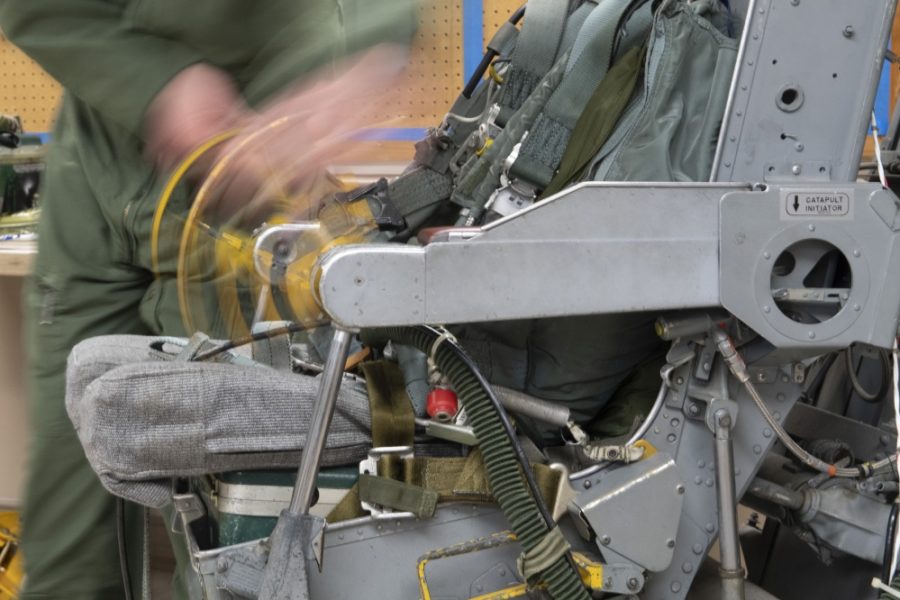A pair of House Armed Services subcommittees, in markups of the 2022 National Defense Authorization Act, pushed back on some Air Force efforts to divest of legacy platforms while also pressing the service to examine the issue of ejection seat safety.
On July 27, the seapower and projection forces subcommittee released its markup, which includes a provision requiring the Air Force to retain a minimum of 287 C-130 aircraft. In its 2022 budget request, USAF had said it planned to gradually reduce the fleet from just over 300 to 255 airframes while it looked to the future of tactical airlift.
It’s not the first time this budget cycle that the Air Force’s plans to reduce the size of legacy fleets has encountered resistance. The Senate Armed Services Committee included a provision in its markup blocking the service from retiring any A-10s, despite its request to mothball 42 of the older close air support planes.
On July 28, the HASC tactical air and land forces subcommittee released its markup, which would require leaders of geographic combatant commands to each submit a report on “the operational risk to that command posed by the restructuring and inventory divestments projected in the Modernization Plan for Airborne Intelligence, Surveillance, and Reconnaissance for the Department of the Air Force.”
Similar to its plan to retire legacy aircraft, the Air Force’s plans for ISR in the 2022 budget have previously encountered resistance in Congress. USAF and Defense Department leaders have pushed to cut a number of combat lines for MQ-9 drones while not actually decreasing the number of tails in the fleet. Doing so, they have argued, will free up funds to modernize some drones and invest in future platforms and sensors.
However, lawmakers have pointed to high demand for MQ-9s from combatant commands as proof that divesting now would be a bad idea. The July 28 subcommittee markup would require six combatant commanders to submit their reports on the risks of divesting by March 30, 2022.
One modernization effort the tactical air and land panel did endorse was the Air Force’s push for digital engineering of weapons systems. In particular, the subcommittee’s markup includes language praising the use of digital engineering on the T-7A trainer, which allowed the service to “nearly [eliminate] manufacturing rework and touch-labor hours to assemble the first aircraft.”
As a result, the subcommittee included a provision directing the Secretary of the Air Force to provide a briefing to the committee by Feb. 15, 2022, on how the Air Force can expand its digital engineering efforts to other systems.
The subcommittee also inserted a number of provisions requiring reports or briefings. In particular, the markup would require the Air Force and Navy secretaries “to provide a report to the congressional defense committees on a semiannual basis that would describe the total quantity of ejection seats currently in operational use that are operating with an approved waiver due to deferred maintenance actions or because required parts or components are not available to replace expired parts or components.”
The panel cited two recent incidents involving ejection seat malfunctions due to deferred maintenance or lack of parts, one of which resulted in the pilot’s death—1st Lt. David Schmitz, an F-16 pilot, died at Shaw Air Force Base, S.C., in June 2020 when he attempted to land with damaged landing gear and his ejection seat failed to work.
According to a report from Military.com, the seat had a part that was considered “expired” in February 2019, but the Air Force Life Cycle Management Center approved three extensions allowing it to remain in operation. It was scheduled to finally receive maintenance between July 8 and Aug. 21, 2020.
Elsewhere in the July 28 markup, the tactical air and land subcommittee directed the Secretary of Defense to compile a report on the number of “spinal-fracture and lumbar compression injuries that have occurred during ejections from Department of Defense aircraft between 1985 and present day.”
Currently, data on the number of such injuries is complicated by departments’ different data-sharing policies and reporting methods, the markup states.
Elsewhere in its markup, the subcommittee included a provision requiring the Defense Secretary to “investigate, assess, and implement” any needed changes to the F-35 breathing system after NASA released a report in May detailing the breathing issues faced by pilots.
The subcommittee also directed the comptroller general to submit a report on the current capabilities and requirements and projected shortfalls for the Air Force’s, Navy’s, and Marine Corps’s tactical aircraft fleets. In particular, the report would focus on how each service’s acquisition and modernization efforts, including the Next-Generation Air Dominance project, would address those shortfalls.
The seapower and projection forces subcommittee adopted its markup July 28 by unanimous consent, while the tactical air and land subcommittee is scheduled to meet and approve its markup July 29. The full committee is scheduled to meet for its markup Sept. 1.

